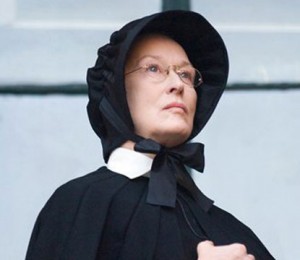
Believe it or not, this is actually a surprise cameo from the new Transformers movie.
After announcing the winners of our Clichemaggedon contest, in which we celebrate both the good and the bad of Summer Movie Season, Belinkie left us with this parting thought:
Gather ye popcorn flicks while ye may, for before you know it we’re going to be neck deep in prestige pictures starring Meryl Streep.
“He’s right,” I thought to myself. “I need to milk this Summer Movie Season and all its gratuitous CGI/3D/sequelness for all it’s worth.”
And then I thought to myself, “Meryl Streep and prestige pictures? We need to quantify this, ideally with some charts and graphs.”
“Obviously.”
If you’re reading this website, you should get Belinkie’s joke, but in case you don’t, here’s the deal: “prestige pictures” are the serious, artsy movies films that studios put out at the end of the year to tee them up for Oscar contention. Meryl Streep has the most Academy Award acting nominations (16) among all actors. Hence the connection between Streep and prestige pictures.
We all know this intuitively, but I thought it would be fun to crunch the numbers to put this in measurable terms. And in the process, I came up with a new way for measuring actors: by their Prestige Factor. In other words, to what degree does an actor’s output trend towards the end of the year as opposed to the spring cleaning of studio crap and the summer tentpole blowing up of studio crap?
Streep’s Stats
By my count, Meryl Streep has starred in 41 movies, from The Deer Hunter in 1978 to It’s Complicated in 2009. I excluded anything she didn’t star in and movies where she only provided voice parts. First, simple question: how do those 41 movies break down by release date?
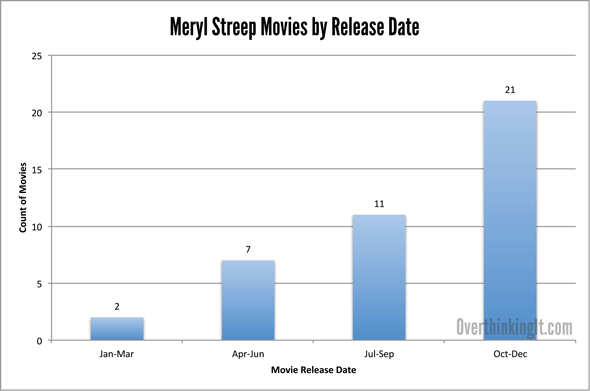
This should be of no surprise. About half (21) of her movies have come out in the October-December quarter. But she does have a large chunk of summer fare as well: 18, if you use the Fast Five “Summer Starts in April” rule of thumb.
So how do we account for this, if this simple breakdown doesn’t tell the whole story? This, my friends, is where the Prestige Factor comes in. The idea is actually pretty simple: for each movie, calculate how late in the year it comes out and put it on a scale of 0-10. A movie that came out on January 1 would be a 0, and movie that came out on December 31–just under the wire for Consideration–would be a perfect 10.
With this scale, we can show how her Prestige Factor changed from year to year (years with multiple movies take the average of all movies):
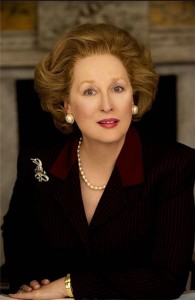
Note: Streep’s next movie is “The Iron Lady,” a Margaret Thatcher biopic. Release date? You guessed it, late 2011.
| Year | Meryl Streep Movie’s Prestige Factor |
| 1978 | 9.37 |
| 1979 | 6.37 |
| 1981 | 7.15 |
| 1982 | 9.11 |
| 1983 | 9.53 |
| 1984 | 8.90 |
| 1985 | 8.42 |
| 1986 | 5.64 |
| 1987 | 9.64 |
| 1988 | 8.63 |
| 1989 | 9.37 |
| 1990 | 6.99 |
| 1991 | 2.22 |
| 1992 | 5.81 |
| 1994 | 4.99 |
| 1995 | 4.19 |
| 1996 | 5.55 |
| 1998 | 7.92 |
| 1999 | 8.27 |
| 2002 | 9.60 |
| 2004 | 7.70 |
| 2005 | 8.25 |
| 2006 | 4.67 |
| 2007 | 7.17 |
| 2008 | 6.02 |
| 2009 | 7.92 |
Here’s how to interpret this: in 2008, Streep starred in 3 movies: Dark Matter (April 11), Mamma Mia! (July 18), and of course, Doubt (December 25), for which she received one of her 16 Oscar nominations. The average of each movie’s Prestige Factor (2.77, 5.45, and 9.84, respectively), gives her a Prestige Factor of 6.02 for that year. Doubt maybe a poster child/whipping boy for prestige pics, but Mamma Mia! is…not so prestigious. Now, compare 2008 to 2002, when both The Hours and Adaptation came out in December, which gives her a mighty 9.6 for that year’s Prestige Factor.
By the way, in case you’re wondering, her Prestige Factor shows no notable trend over time, other than a dip in 1991 that’s the result of Defending Your Life (March 22). Behold, the Prestige Factor line graph:
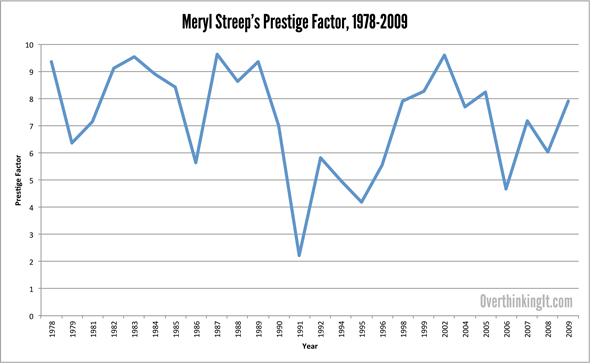
And finally, this leads us to Streep’s overall career Prestige Factor, the average of all of her individual movies’ factors:

7.18 out of a possible 10! While high, it’s not stratospherically so. Which goes to show us that although it’s easy to associate Streep with late-year art house Oscar bait, there’s a decent amount of She-Devil! and Death Becomes Her to balance things out a bit.
Now, at this point, if you’ve read any of our other articles on statistics, you know that any given data point–in this case, Streep’s Prestige Score of 7.18–isn’t particularly interesting without anything to compare it to.
So with that in mind, ladies and gentlemen, I present for comparative purposes, Mr. Vin Diesel.

Diesel’s Data
First, I should say that I don’t make this comparison to disparage Vin Diesel in any way. He’s pretty good at what he does. But let’s put it this way: there is no Oscar for Best Supporting Biceps. Vin Diesel is not thought of as a prestige picture actor in the way that Meryl Streep is. In fact, he’s about as far away from such an actor that you could possibly get while staying within the boundaries of A-list actors.
With that said, let’s see how Diesel’s movies break down by release date. For 13 movies that he’s starred in, from Boiler Room in 2000 to Fast Five in 2011, almost half of them were released in the April-June quarter:
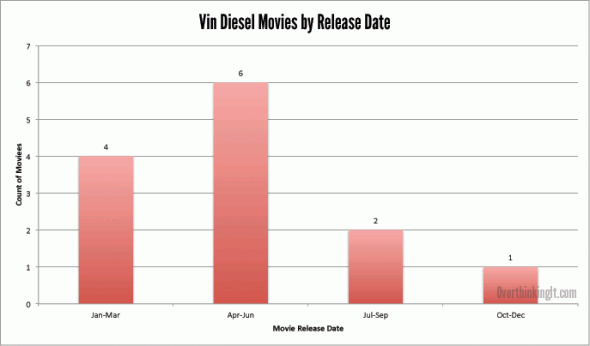
Here’s the year-by-year Prestige Factor aggregation and trend:
| Year | Vin Diesel Movie’s Prestige Factor |
| 2000 | 1.32 |
| 2001 | 4.74 |
| 2002 | 6.92 |
| 2003 | 2.58 |
| 2004 | 4.44 |
| 2005 | 1.73 |
| 2006 | 3.33 |
| 2008 | 6.60 |
| 2009 | 2.55 |
| 2011 | 3.26 |
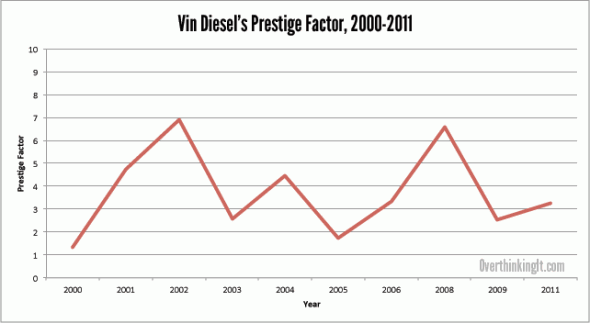
As was the case with Streep, Diesel’s career shows no discernable trend in Prestige Factor from year to year, but that’s pretty much where the similarities end. Yes, it’s obvious that Vin Diesel is not the prestige picture actor that Meryl Streep is, so let’s see what his overall career Prestige Factor is:

There you have it. Now you know how far Vin Diesel is from Meryl Streep prestige territory: 7.18 versus 3.77. Oh, and Meryl Streep did a Holocaust movie. Get on that, Vin Diesel.
Actually, on second thought, don’t get on that. Stick with the new Riddick movie.
Readers: Join in on the fun! I challenge you to find an actor whose Prestige Factor is either higher than Meryl Streep or lower than Vin Diesel. I’m pretty sure that Streep and Diesel don’t represent the extreme ends of this spectrum. Take this Excel spreadsheet as an example and go to town!
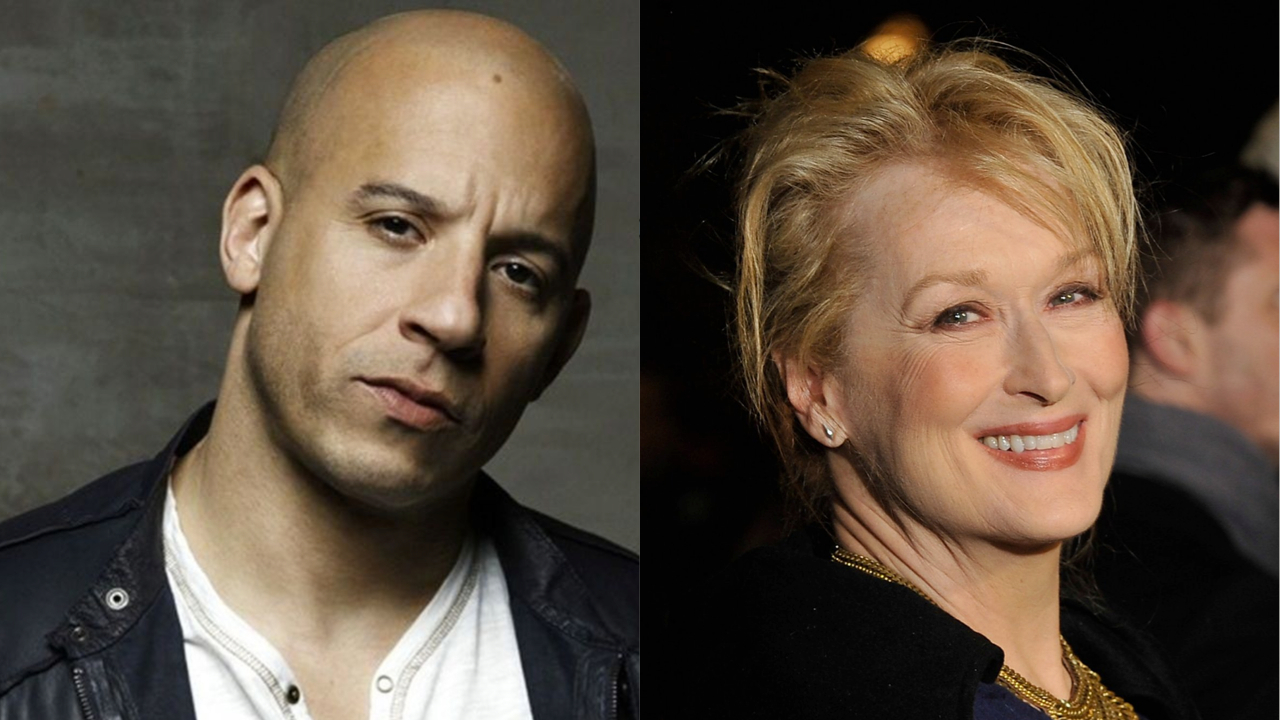

I’m busy at work today, but after I get home I think I’m going to crunch the numbers on Anthony Hopkins
A: Saving Private Ryan, if not a Holocaust movie, is at least orthogonal to one.
B: Don’t you dare say an unkind word about Death Becomes Her.
No unkindness was meant towards “Death Becomes Her.” I was just using it as an example of a non-prestige movie in that A) it was released on July 31 and B) it’s a comedy (to my knowledge–I’ve actually never seen it).
“I’ve actually never seen it.”
I’m in shock. Bruce Willis? C’mon, dude.
Agreed. I loves me some Death Becomes Her.
Al Pacino: 6.88
I was sure it’d end up higher than that when I was putting in the info, but The Recruit, Donnie Brasco, City Hall, Cruising, and, oddly enough, The Godfather ultimately killed his prestige numbers.
Also, I feel the need to mention that Pacino got more prestige points for Gigli than he did for the Godfather. Go figure.
I looked up “Gigli” on IMDB to find its release date (July 27) and came away with something much better: perhaps the best log line ever.
A. Saving Private Ryan shouldn’t be included since he wasn’t a star of the film. Since that criteria was used against Streep it has to be used for Diesel.
B. I would hope that was not an unkind word about Defending Your Life!
A. That’s correct; I used the same criteria for both actors, so SPR is not part of the Vin Diesel dataset.
B. I haven’t seen “Defending Your Life”; I only used it as an example of a Streep movie that was released much earlier in the year compared to the rest of her movies.
Wow, everyone rising up to defend their beloved Meryl Streep movies. Any takers for “She-Devil”?
Don’t you think summer movies should have the lowest prestige factor? I’m not much of a movie person, but it seems plausible that studios would also try to release prestige films early in the year to make an impression as early Oscar candidate. And summer movies are mostly big-budget trash.
I would like to see the results if you rated prestige on some kind of annual sag curve that bottoms out around July 1.
Conventional wisdom holds that studios dump the movies they expect to bomb between January and March. Summer is for tentpole flicks that will bring in lots of revenue. Autumn is for prestige pictures. Late winter (post-Christmas until spring) is for garbage.
Consider 2011’s winter release schedule (Jan-Feb):
Season of the Witch
The Green Hornet
No Strings Attached
The Roommate
Gnomeo and Juliet
The Eagle
I Am Number Four
Big Mommas
Drive Angry
Hall Pass
Some good movies slipped in here as well – Cedar Rapids, the domestic release of Biutiful – but primarily garbage.
I don’t have the time to put the time in on it now, but I’d be willing to bet that Rob Schneider dips under the Diesel line…
I don’t know about other awards, but to be considered for an Academy Award, the movie must play at the least for one week in either NYC or Los Angeles. This would make a 12/31 release ineligible for that calendar year (and hence 12/25 release for big prestige films, as Christmas is historically one of the biggest days for movie-going in the US).
Patrick
While this is true, it doesn’t change any of the Prestige Factor calculations. PF is based on “Days remaining in the year since release.” So if you end the year on 12/25 rather than 12/31, every PF just gets moved back 7 days.
HOWEVER: if you based each year’s numbers on the maximum Prestige Factor, instead of the average Prestige Factor, everything changes. And there’s a lot to be said for counting the most prestigious movie an actor makes in a year. Halle Berry put out Swordfish and Monster’s Ball in the same year, but it’s not as if the former hurt her Oscar chances for the latter.
Yes, this means that an actor can get away with a lot of crap provided he’s in one prestigious movie every year. But anecdotal evidence bears this out. We the moviegoing public forgive George Clooney any number of Spy Kids 3Ds so long as he tosses us the occasional Coen Bros. flick (e.g., Intolerable Cruelty, the same year as Spy Kids 3D). And when people think of Mickey Rourke in 2008, they think of The Wrestler, not Killshot.
I’ve been crunching the numbers of Oscar nominees for Best Picture (and looking at winners too, obviously) and there’s only been two instances of films pulling that kind of a tight release at the end of the year – Gosford Park and Traffic, which released in both LA and NYC on the 26th and 27th respectively, and opened to a broader audience some time in early January. All other films since 1997 (I’m using Titanic as a cut off point here) have had at least a “limited” release, which tends to include more major cities, at some point in December.
I know it’s common knowledge that Christmas and even more so the weird period between Christmas and New Year’s Day are an ideal time for movie theaters with poor weather and lots of kids and teens (and even college students) out of school, but I think studios are still super cautious. There were a lot of films that didn’t get so close to the cut off point but did similar, highly limited releases during (usually earlier) December only to open to more theaters in (early-ish) January.
I’m guessing here, but it seems like the “more adult” movies that tend to dominate the Oscars and other awards programs aren’t as marketable under those conditions as we might think. Kids are usually out of school during that period, so a big part of the market gets eaten up by “family friendly” kids’ movies. The kind of films that regularly get nominated for Oscars seem to frequently stick a toe in during December, both to qualify for the closer awards season and as a way to see how well their film tests with audiences. Where they release themselves more broadly to the public, ostensibly for profit, is in January, when work and school schedules apparently make it more easy for “adult” films to compete.
I’m still crunching the numbers on the “prestige reading” for Best Picture nominees and winners in the past 14 years, but I’ll drop a link to it once I get done (hopefully by tomorrow).
Could be interesting to turn this around, and say what is the prestige factor of a big Oscar movie in a given year.
Take, say, Best Actor, Best Actress and Best Movie (or whatever categories you think best), and of all movies nominated (inc winners) what is the average prestige factor?
And then the prestige factor of the winners?
Then, bam, time series for those two factors!
That should be evidence towards big prestige movies being Oscar winners, rather than ‘recieved wisdom’.
I’m crunching those numbers right now. I don’t have the math done to say it authoritatively, but it really looks like the ‘received wisdom’ is born out in the past 14 years.
I’m using Titanic as a starting point, because it supposedly showed the limitations of corporate dominance in the films industry and the re-emergence of creative checks on the business model – I’m not sure if I believe all that, but it definitely changed the way movies were thought of at the least, so I’m sticking to it as the start of the current status quo.
My only issue here is that late in the year is also where hollywood pushes the mass-marketed family movies (eg Alvin and the Chipmunks), which are typically as far from prestiege pictures as possible. There’s a lot of noise just going by release date.
That, and the fact that some prestiege films with a broad audience (eg, the Godfather and Inception) will get pushed in the summer, too, as they are intended to be four segment megahits.
Definitely, this seems to be affecting the data (looking just at Oscar Nominees for Best Picture, admittedly) more than un-prestigious Christmas season “family films” do. The slightly smarter action-oriented films (Saving Private Ryan, Gladiator, Seabiscuit, The Hurt Locker, Inglorious Bastards, and Inception) tend to have early summer release dates.
There’s also a couple of Summer season “family films” (which have had to be a bit darker than the typical “family films” though) that made it to the Oscars – Toy Story 3 and Up. These tend to come out in the same early Summer period around June or May that the action films do – they’re both aiming for the same post-school bump in teen or child viewers.
Likewise, there’s a number of Summer season films that kind of reek of “experimental” or “quirky” that honestly probably weren’t seen as potential Oscar nominees – The Full Monty, The Sixth Sense, Little Miss Sunshine, and Moulin Rouge! (yes, the exclamation point is part of the name). I think District 9 might belong in that category too, but I’m not sure. These are somewhat scattered throughout the summer season, much less concentrated at the beginning (The Sixth Sense, for example, opened in August). Maybe they were just trying to jump into the summer season without trying to compete with the bigger names at the beginning?
There’s really only one other group of nominated films outside of those with September to December release dates – message films. Some of those are in the summer, like The Kids Are All Right (which came out in July), but some seem to be aiming for the early summer bump, like Crash (which came out in May), and a few others seem exiled to the dead zone of spring release, like Erin Brockovich (which came out in March, the only Best Picture nominee in the past fourteen years to have a limited or full release in the USA during the third of the year between January 5th and May 5th).
So there’s a lot of different factors that can lead to a non-winter/fall release date for a film, but its still pretty clear that those releases, at least for the type of movies that get nominated for Best Picture, aren’t the default, which seems centered pretty strongly in December.
Do I have to input these titles and release dates to the spreadsheet manually or is there another way to export them from IMDB?
Manual data entry all the way. If there were some sort of “export from IMDB” function, then you’d see a post like this from me every week instead of every month or every other month.
Is there a way to determine when summer became “popcorn flick” season? I only ask because I think the validity of the prestige factor depends rather heavily on this. Also, I think variance in prestige factor (Standard Deviation) would be an interesting statistic in and of itself. For example, I imagine that Daniel Day Lewis would have a small standard deviation whereas someone like Nick Cage would have a high standard deviation. Something worth thinking about.
If I’m not mistaken, Jaws is usually credited as the first “summer blockbuster” in the current sense.
and if not “jaws” then certainly “star wars” two years later. i’ve seen them both credited in this sense (though, unless i’m mistaken, “star wars” was put as a summer release because the studio didn’t think it would do very well).
so, in that sense, “jaws” very well may be the first “summer blockbuster”, but it wasn’t standard practice to put the “blockbuster” movies out during the summer months until at least after “star wars” was released.
So there you go. Speaking specifically about Pacino (as mentioned above). Godfather (1972) shouldn’t count against his prestige numbers because it came out before this current style of movie releases (read: Pre-1975). I’m too lazy to do it, but I still think the Standard Deviation would be helpful. For instance, keeping with the example used in this post, Streep not only has a higher prestige number than Vin D. but also her number is more reliable because it is based on more observations (movies).